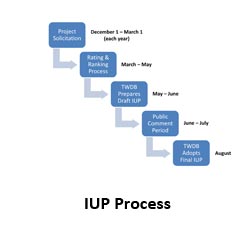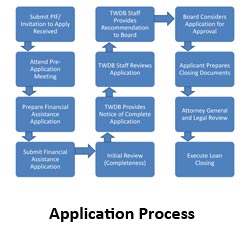Clean Water State Revolving Fund (CWSRF) Loan Program
CWSRF Program Information Sheet
Clean Water State Revolving Fund Loan Program (CWSRF)
View State Revolving Fund Webinar
State Revolving Fund Programs Webinar PDF
State Revolving Fund Program FAQs
Project Information Form Webinar FAQs
1. What can the program do for you?
The Clean Water State Revolving Fund, authorized by the Clean Water Act, provides low-cost financial assistance for planning, acquisition, design, and construction of wastewater, reuse, and stormwater infrastructure.
2. Who can borrow?
Eligible applicants for the CWSRF program include cities, counties, districts, river authorities, designated management agencies, authorized Indian tribal organizations, and public and private entities proposing nonpoint source or estuary management projects.
3. What types of projects can I use the loan funding for?
Financial assistance from the CWSRF program can be utilized for:
- Create or improve wastewater treatment facilities, reuse/recycle facilities, and collection systems
- Purchase existing wastewater treatment plants
- Purchase land necessary for construction of an eligible project
- Manage, reduce, treat, or recapture stormwater or subsurface drainage water
- Nonpoint source pollution control projects
- Estuary management projects
- Implement green projects (pursuant to EPA guidance)
- Develop and implement watershed pilot projects
- Disaster recovery
- Increase the security of POTWs
- Water meters as a water conservation measure
- Pay for other costs necessary to secure and issue debt
4. Are loans or grants offered?
Below market interest rate loans, 0% loans and principal forgiveness (similar to grants) are offered in the State Revolving Fund (SRF) Intended Use Plan (IUP).
The interest rate on loans will be a percentage reduction from the Thomson Reuters Municipal Market Data (MMD) rate adjusted for yield to maturity that is applicable to the entity's rating, with non-rated entities using the Baa rate, as follows:
(a) Equivalency projects: 35% reduction
(b) Non-Equivalency projects: 30% reduction
0% loans are available on a limited basis to eligible small/rural disadvantaged communities, urgent need projects and for preparation of Asset Management Plans.
Principal forgiveness is available on a limited basis to eligible applicants.
- Disadvantaged communities: The amount of principal forgiveness for a regular disadvantaged project (up to 70%) is dependent on the annual median household income (AMHI) and household cost factor (HCF) for the project area.
- Small/rural disadvantaged communities: Entities qualified as a disadvantaged community and that additionally meet the definition of either a small community (serve a population of 10,000 or fewer) or a rural project (see definition in the IUP) are eligible for up to 100% principal forgiveness ($1,000,000 maximum).
- Very disadvantaged communities: Entities that qualified as a disadvantaged community and have a service area AMHI that is below 50 percent of the state-wide average AMHI are eligible for up to $1,000,000 in principal forgiveness.
- Very small systems: Projects that serve a population of 1,000 or fewer are eligible for up to 100% principal forgiveness ($400,000 maximum).
- Green projects: Entities may receive subsidized green funding (up to 15% forgiveness) if their project has eligible components that total 30% of the project's total cost.
- Urgent need projects: If a project is determined to be of urgent need, the applicant may qualify for 100% principal forgiveness ($500,000 maximum unless a disadvantaged community, then up to $800,000 maximum). The project must not be for replacement of facilities that have failed because they exceeded their useful life or failed due to lack of adequate maintenance.
- First-time service: Projects that include first-time service to households not currently served by a centralized public water system are eligible up to $200,000 in principal forgiveness.
A useful table under Section V of the IUP called "Allocations and Terms Available Under Each Funding Option" lists the principal forgiveness options and the loan options.
5. What phases of the project are eligible for funding?
The CWSRF program provides financial assistance for planning, acquisition, design, and construction of your wastewater, reuse, and/or stormwater project.
6. How much funding is available?
Whether you are seeking financial assistance for smaller projects or large-scale capital improvement projects, the CWSRF program is an excellent fit for your system's needs. For State Fiscal Year 2024, at least $460 Million is available under the CWSRF program for all financing options including $55 Million in principal forgiveness. This funding consists of the annual appropriations from the CWSRF capitalization grant funds and the supplemental appropriations from the Infrastructure Investment and Jobs Act of 2021 (IIJA).
For current detailed information regarding funds available, please see the CWSRF Intended Use Plan located on the upper right side of this webpage.
7. When can I apply for SRF financial assistance?
Solicitation for the SRF Programs opens in December of every year and closes in March of the following year. Entities must submit a completed Project Information Form (PIF) by the deadline to be invited to apply for funding under the initial IUP. Join our mailing list so you are notified of when solicitation opens and of all important deadlines. You may submit a PIF for funding at any time. However, your project will not be included in the initial project priority list if it is not submitted by the solicitation deadline.
Special Requirements
Financial assistance through the CWSRF program requires compliance with applicable rules, policies, and statutes including:
- Submittal of a Project Information Form (PIF) to be listed in the current Intended Use Plan (IUP)
- 1.75% loan origination fee
- National Environmental Policy Act-type environmental review
- Adoption of a Water Conservation and Drought Contingency Plan for all financial assistance greater than $500,000
- Application of Davis-Bacon wage rate requirements
- Compliance with EPA's American Iron and Steel Provisions
- Additional steps when procuring architecture and engineering services
-
For Equivalency Projects:
- Compliance with the EPA's Disadvantaged Business Enterprise program, which requires applicants and prime contractors to follow six affirmative steps in procurement (Guidance and additional information is available)
- Compliance with EPA's Build America, Buy America (BABA) Act
IUP and Loan Process


Where Can I Get More Information?
In order to provide you with a single point of contact at the TWDB, our project implementation staff is organized into six regional project implementation teams. Each team is led by a manager that serves as the primary point of contact for both our existing and future customers. For assistance with the application or any questions related to your project, please look up contact information for your Regional Team.